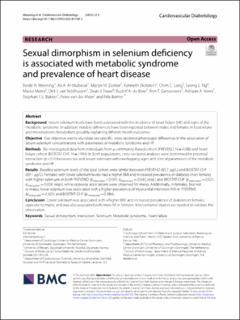| dc.contributor.author | Weening, Eerde H. | |
| dc.contributor.author | Al-Mubarak, Ali A. | |
| dc.contributor.author | Dokter, Martin M. | |
| dc.contributor.author | Dickstein, Kenneth | |
| dc.contributor.author | Lang, Chim C. | |
| dc.contributor.author | Ng, Leong L. | |
| dc.contributor.author | Metra, Marco | |
| dc.contributor.author | van Veldhuisen, Dirk J. | |
| dc.contributor.author | Touw, Daan J. | |
| dc.contributor.author | de Boer, Rudolf A. | |
| dc.contributor.author | Gansevoort, Ron T. | |
| dc.contributor.author | Voors, Adriaan A. | |
| dc.contributor.author | Bakker, Stephan J. L. | |
| dc.contributor.author | van der Meer, Peter | |
| dc.contributor.author | Bomer, Nils | |
| dc.date.accessioned | 2023-07-13T06:56:37Z | |
| dc.date.available | 2023-07-13T06:56:37Z | |
| dc.date.created | 2023-03-31T14:43:51Z | |
| dc.date.issued | 2023 | |
| dc.identifier.issn | 1475-2840 | |
| dc.identifier.uri | https://hdl.handle.net/11250/3078514 | |
| dc.description.abstract | Background
Serum selenium levels have been associated with the incidence of heart failure (HF) and signs of the metabolic syndrome. In addition, notable differences have been reported between males and females in food intake and micronutrient metabolism, possibly explaining different health outcomes.
Objective
Our objective was to elucidate sex-specific, cross-sectional phenotypic differences in the association of serum selenium concentrations with parameters of metabolic syndrome and HF.
Methods
We investigated data from individuals from a community-based cohort (PREVEND; N = 4288) and heart failure cohort (BIOSTAT-CHF; N = 1994). In both populations, cross-sectional analyses were performed for potential interaction (p < 0.1) between sex and serum selenium with overlapping signs and clinical parameters of the metabolic syndrome and HF.
Results
Baseline selenium levels of the total cohort were similar between PREVEND (85.7 μg/L) and BIOSTAT-CHF (89.1 μg/L). Females with lower selenium levels had a higher BMI and increased prevalence of diabetes than females with higher selenium, in both PREVEND (pinteraction < 0.001; pinteraction = 0.040, resp.) and BIOSTAT-CHF (pinteraction = 0.021; pinteraction = 0.024, resp.), while opposite associations were observed for males. Additionally, in females, but not in males, lower selenium was associated with a higher prevalence of myocardial infarction (MI) in PREVEND (pinteraction = 0.021) and BIOSTAT-CHF (pinteraction = 0.084).
Conclusion
Lower selenium was associated with a higher BMI and increased prevalence of diabetes in females, opposite to males, and was also associated with more MI in females. Interventional studies are needed to validate this observation. | en_US |
| dc.language.iso | eng | en_US |
| dc.publisher | BMC | en_US |
| dc.rights | Navngivelse 4.0 Internasjonal | * |
| dc.rights.uri | http://creativecommons.org/licenses/by/4.0/deed.no | * |
| dc.title | Sexual dimorphism in selenium deficiency is associated with metabolic syndrome and prevalence of heart disease | en_US |
| dc.type | Journal article | en_US |
| dc.type | Peer reviewed | en_US |
| dc.description.version | publishedVersion | en_US |
| dc.rights.holder | Copyright The Author(s) 2023 | en_US |
| dc.source.articlenumber | 8 | en_US |
| cristin.ispublished | true | |
| cristin.fulltext | original | |
| cristin.qualitycode | 1 | |
| dc.identifier.doi | 10.1186/s12933-022-01730-2 | |
| dc.identifier.cristin | 2138920 | |
| dc.source.journal | Cardiovascular Diabetology | en_US |
| dc.identifier.citation | Cardiovascular Diabetology. 2023, 22, 8. | en_US |
| dc.source.volume | 22 | en_US |

